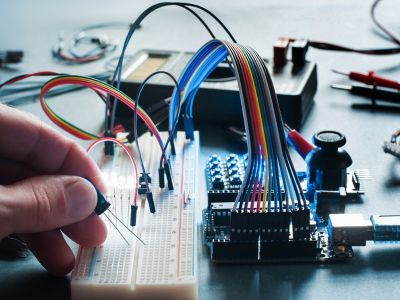Avoid Overloading Electrical Circuits
One of the most frequent and hazardous reasons for electrical fires in residences and commercial buildings is electrical circuit overload. An overload can result in overheating, damaged wiring, and even fires when an electrical circuit is carrying more current than it is intended to. Maintaining safety and making sure your electrical system operates effectively requires knowing how to prevent overloading electrical circuits. Dynamic Electric World will walk you through the causes, symptoms, and ways to avoid electrical circuit overloads in this blog.

What Is an Electrical Circuit Overload?
When too many devices are connected to a circuit, the connection draws more current than the wiring or circuit breaker is designed to handle. This is known as an electrical circuit overload. A particular amount of current, usually expressed in amperes (amps), is intended to flow through electrical circuits; if this limit is exceeded, the wire may heat up and may sustain damage or even catch fire. Electrical systems are equipped with circuit breakers and fuses to prevent overloads by cutting off the power supply in the event that the circuit is overloaded.
Common Causes of Electrical Overloads
Understanding the causes of electrical circuit overloads can help you prevent them:
- Too Many Appliances on One Circuit: Plugging too many appliances or gadgets into one circuit is one of the most frequent causes of an overload. This frequently occurs in spaces where multiple gadgets require power simultaneously, such as living rooms, kitchens, or home offices.
- High-Powered Appliances: Irons, toasters, microwaves, air conditioners, space heaters, and other appliances use a lot of electricity. The circuit’s capacity can be readily exceeded when more of these devices are connected to it.
- Power Strips and Extension Cords: Using several power strips or extension cords might result in overloading, notwithstanding their convenience. The circuit limit may be exceeded if an excessive number of devices are connected to a single power strip or extension cord.
- Wire Problems: The demands of contemporary electrical equipment may be too much for older wire systems to manage. Overloads may occur frequently if your wiring is old or broken.
- Faulty Circuit Breakers: When an overload develops, a worn-out or malfunctioning circuit breaker may not trip, allowing the circuit to continue carrying an excessive amount of electricity.
Signs of an Overloaded Circuit
Knowing the symptoms of an overloaded circuit will help you take care of the problem before it gets out of hand. Typical signs of overloads include:
- Tripped Circuit Breakers: An overloaded circuit is indicated if your circuit breaker trips regularly. To stop damage or fires, a circuit breaker is made to trip when it senses an overload.
- Dimming or flickering lights: If your home’s lights dim or flicker when you turn on several gadgets, it may indicate that your circuit is having trouble managing the load.
- Burning Smells or Hot Outlets: It’s obvious that the wiring is overheating if you smell burning near switches or outlets. Devices should be unplugged right away, and until a qualified electrician inspects the outlet, you should not use it.
- Warm or Hot Electrical Panels: If your circuit breaker box or electrical panel feels warm to the touch, it can be a sign of an overload, which could harm the wiring or the panel itself.
- Buzzing Noises: Strange buzzing or sizzling sounds from outlets or appliances could indicate a stressed and overheated circuit.

How to Avoid Overloading Electrical Circuits
- Recognize your circuit’s amperage. Every electrical circuit has a rated amperage, which in most homes is 15 or 20 amps. Understanding the maximum current your circuit can withstand is crucial to preventing overloading. Usually, the breaker in your panel will have this information. Don’t connect too many devices to the same circuit in order to go above this limit.
- Assign electrical loads to Various Circuits Distribute your electrical appliances over several circuits to prevent overloading one. For instance, to prevent them from drawing too much power from the same source, position major equipment like space heaters and refrigerators on different circuits.
- Restrict the Use of Power Strips and Extension Cords Power strips and extension cords are handy, but if too many devices are connected, they may overload. Avoid Daisy-chaining several power strips together and only use one appliance per power strip. Rather, think about expanding your electrical system or adding more outlets to meet your needs.
- Make Electrical System Upgrades Your electrical system might not be able to support the demands of contemporary devices and appliances if your house is older. To avoid overloads and guarantee the safety of your house, you might need to upgrade your electrical panel or add more circuits.
- Make use of energy-saving appliances. The load on your circuits can be lessened by making the switch to energy-efficient equipment, such as LED lightbulbs, energy-efficient refrigerators, and other environmentally friendly gadgets. Because these gadgets use less electricity, you may avoid overloading and use less energy overall.
- Examine and Maintain Your Electrical System Maintaining your electrical system on a regular basis is essential to avoiding overloads. It’s crucial to have a qualified electrician examine and, if required, replace the wiring if you see wear indicators like frayed wires, exposed insulation, or old wiring.
- Make use of energy-saving appliances. The load on your circuits can be lessened by making the switch to energy-efficient equipment, such as LED lightbulbs, energy-efficient refrigerators, and other environmentally friendly gadgets. Because these gadgets use less electricity, you may avoid overloading and use less energy overall.
- Examine and Maintain Your Electrical System Maintaining your electrical system on a regular basis is essential to avoiding overloads. It’s crucial to have a qualified electrician examine and, if required, replace the wiring if you see wear indicators like frayed wires, exposed insulation, or old wiring.
Conclusion
Although overloading electrical circuits is a major safety risk, you may avoid it in your house or place of business by taking the appropriate safety measures. You can guarantee that your electrical system runs effectively and safely by being aware of the causes of overloads, identifying the warning indications, and taking the appropriate precautions.
Our goal at Dynamic Electric World is to assist you in keeping your home’s electrical system secure and operational. Our knowledgeable electricians are always available to help if you think there may be an overload or if you need suggestions for improving your electrical system. Never hesitate to seek the advice of a qualified expert while handling any electrical issues.
